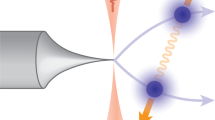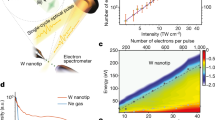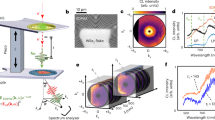Abstract
Conventional metal-tip-based laser-driven electron sources are normally constrained by a trade-off between energy spread and pulse width due to optical-field-induced free electron acceleration. This makes it challenging to surpass the current state-of-the-art, which exhibits energy spreads exceeding 1 eV and pulse durations of hundreds of femtoseconds. Here we report an unconventional delayed emission from a one-dimensional carbon-nanotube-based electron source. By utilizing a special pump–probe approach, we apply 7-fs laser pulses to the carbon-nanotube emitters and observe free electron emission tens of femtoseconds after the pulse. This delayed emission results in a substantially reduced energy spread of approximately 0.3 eV and an electron pulse width of about 13 fs. Through time-dependent density functional theory calculations, we find that the delayed emission is driven by the interplay of collective oscillations and electron–electron interactions. Our results may provide a promising technology for developing cutting-edge ultrafast electron sources.
This is a preview of subscription content, access via your institution
Access options
Access Nature and 54 other Nature Portfolio journals
Get Nature+, our best-value online-access subscription
$32.99 / 30 days
cancel any time
Subscribe to this journal
Receive 12 print issues and online access
$259.00 per year
only $21.58 per issue
Buy this article
- Purchase on SpringerLink
- Instant access to full article PDF
Prices may be subject to local taxes which are calculated during checkout



Similar content being viewed by others
Data availability
All data are available in the Supplementary Information. Source data are provided with this paper.
References
Barwick, B., Flannigan, D. J. & Zewail, A. H. Photon-induced near-field electron microscopy. Nature 462, 902–906 (2009).
Zewail, A. H. Four-dimensional electron microscopy. Science 328, 187–193 (2010).
Hassan, M. T., Baskin, J. S., Liao, B. & Zewail, A. H. High-temporal-resolution electron microscopy for imaging ultrafast electron dynamics. Nat. Photonics 11, 425–430 (2017).
Kurman, Y. et al. Spatiotemporal imaging of 2D polariton wave packet dynamics using free electrons. Science 372, 1181–1186 (2021).
Gulde, M. et al. Ultrafast low-energy electron diffraction in transmission resolves polymer/graphene superstructure dynamics. Science 345, 200–204 (2014).
Priebe, K. E. et al. Attosecond electron pulse trains and quantum state reconstruction in ultrafast transmission electron microscopy. Nat. Photonics 11, 793–797 (2017).
Domroese, T. et al. Light-induced hexatic state in a layered quantum material. Nat. Mater. 22, 1345–1351 (2023).
Horstmann, J. G. et al. Coherent control of a surface structural phase transition. Nature 583, 232–234 (2020).
Danz, T., Domrose, T. & Ropers, C. Ultrafast nanoimaging of the order parameter in a structural phase transition. Science 371, 371–374 (2021).
Kim, H. et al. Attosecond field emission. Nature 613, 662–666 (2023).
Dienstbier, P. et al. Tracing attosecond electron emission from a nanometric metal tip. Nature 616, 702–706 (2023).
Herink, G., Solli, D. R., Gulde, M. & Ropers, C. Field-driven photoemission from nanostructures quenches the quiver motion. Nature 483, 190–193 (2012).
Krueger, M., Schenk, M. & Hommelhoff, P. Attosecond control of electrons emitted from a nanoscale metal tip. Nature 475, 78–81 (2011).
Corkum, P. B. Plasma perspective on strong-field multiphoton ionization. Phys. Rev. Lett. 71, 1994–1997 (1993).
Paulus, G. G., Becker, W. & Walther, H. Classical rescattering effects in 2-color above-threshold ionization. Phys. Rev. A 52, 4043–4053 (1995).
Bormann, R., Gulde, M., Weismann, A., Yalunin, S. V. & Ropers, C. Tip-enhanced strong-field photoemission. Phys. Rev. Lett. 105, 147601 (2010).
Yanagisawa, H. et al. Optical control of field-emission sites by femtosecond laser pulses. Phys. Rev. Lett. 103, 257603 (2009).
Hommelhoff, P., Sortais, Y., Aghajani-Talesh, A. & Kasevich, M. A. Field emission tip as a nanometer source of free electron femtosecond pulses. Phys. Rev. Lett. 96, 077401 (2006).
Ropers, C., Solli, D. R., Schulz, C. P., Lienau, C. & Elsaesser, T. Localized multiphoton emission of femtosecond electron pulses from metal nanotips. Phys. Rev. Lett. 98, 043907 (2007).
Musumeci, P. et al. Multiphoton photoemission from a copper cathode illuminated by ultrashort laser pulses in an RF photoinjector. Phys. Rev. Lett. 104, 084801 (2010).
Shafir, D. et al. Resolving the time when an electron exits a tunnelling barrier. Nature 485, 343–346 (2012).
Pedatzur, O. et al. Attosecond tunnelling interferometry. Nat. Phys. 11, 815–819 (2015).
Nabben, D., Kuttruff, J., Stolz, L., Ryabov, A. & Baum, P. Attosecond electron microscopy of sub-cycle optical dynamics. Nature 619, 63–67 (2023).
Schenk, M., Krueger, M. & Hommelhoff, P. Strong-field above-threshold photoemission from sharp metal tips. Phys. Rev. Lett. 105, 257601 (2010).
Li, C. et al. Extreme nonlinear strong-field photoemission from carbon nanotubes. Nat. Commun. 10, 4891 (2019).
Li, C. et al. Carbon nanotubes as an ultrafast emitter with a narrow energy spread at optical frequency. Adv. Mater. 29, 1701580 (2017).
De Jonge, N. et al. High brightness electron beam from a multi-walled carbon nanotube. Nature 420, 393–395 (2002).
De Jonge, N. & Bonard, J. M. Carbon nanotube electron sources and applications. Philos. Trans. R. Soc. Lond. A 362, 2239–2266 (2004).
Saito, Y. & Uemura, S. Field emission from carbon nanotubes and its application to electron sources. Carbon 38, 169–182 (2000).
Achermann, M., Bartko, A. P., Hollingsworth, J. A. & Klimov, V. I. The effect of Auger heating on intraband carrier relaxation in semiconductor quantum rods. Nat. Phys. 2, 557–561 (2006).
Keldysh, L. Ionization in the field of a strong electromagnetic wave. Sov. Phys. JETP 20, 1307–1314 (1965).
Bunkin, F. & Fedorov, M. Cold emission of electrons from the surface of a metal in a strong radiation field. Sov. Phys. JETP 21, 896 (1965).
Zhang, P. & Lau, Y. Y. Ultrafast strong-field photoelectron emission from biased metal surfaces: exact solution to time-dependent Schrödinger equation. Sci. Rep. 6, 19894 (2016).
Piglosiewicz, B. et al. Carrier-envelope phase effects on the strong-field photoemission of electrons from metallic nanostructures. Nat. Photonics 8, 37–42 (2014).
Bionta, M. R. et al. On-chip sampling of optical fields with attosecond resolution. Nat. Photonics 15, 456–460 (2021).
Tan, S. J., Argondizzo, A., Wang, C., Cui, X. F. & Petek, H. Ultrafast multiphoton thermionic photoemission from graphite. Phys. Rev. X 7, 011004 (2017).
Liu, K. H. et al. Quantum-coupled radial-breathing oscillations in double-walled carbon nanotubes. Nat. Commun. 4, 1375 (2013).
Kresse, G. & Furthmüller, J. Efficient iterative schemes for ab initio total-energy calculations using a plane-wave basis set. Phys. Rev. B 54, 11169 (1996).
Perdew, J. P., Burke, K. & Ernzerhof, M. Generalized gradient approximation made simple. Phys. Rev. Lett. 77, 3865 (1996).
Andrade, X. et al. Real-space grids and the Octopus code as tools for the development of new simulation approaches for electronic systems. Phys. Chem. Chem. Phys. 17, 31371–31396 (2015).
Onida, G., Reining, L. & Rubio, A. Electronic excitations: density-functional versus many-body Green’s-function approaches. Rev. Mod. Phys. 74, 601 (2002).
D’Agosta, R. & Vignale, G. Relaxation in time-dependent current-density-functional theory. Phys. Rev. Lett. 96, 016405 (2006).
Hartwigsen, C., Gœdecker, S. & Hutter, J. Relativistic separable dual-space Gaussian pseudopotentials from H to Rn. Phys. Rev. B 58, 3641 (1998).
De Giovannini, U., Larsen, A. H. & Rubio, A. Modeling electron dynamics coupled to continuum states in finite volumes with absorbing boundaries. Eur. Phys. J. B 88, 56 (2015).
Wang, F. et al. The optical resonances in carbon nanotubes arise from excitons. Science 308, 838–841 (2005).
Maultzsch, J. et al. Exciton binding energies in carbon nanotubes from two-photon photoluminescence. Phys. Rev. B 72, 241402 (2005).
Acknowledgements
We acknowledge funding from the National Key Research and Development Program of China (grant numbers 2022YFA1204200 (C.L.), 2021YFC2802000 (Z.L.), 2023YFF0723800 (C.L.), 2022YFA1604301 (R.L.), 2022YFA1403601 (X. Wan)), the Natural Science Foundation of China (grant numbers 52222207 (C.L.), 5225000143 (C.L.), 52372141 (Z.L.), 52302170 (A. Wang), 12174195 (C.Y.), 12188101 (X. Wan), 12234020 (X. Wang), 12450403 (X. Wang), 12425411 (R.L.) and 12434013 (C.Y.)), the Young Scientist Basic Research Program of CAS (YSBR-091 (C.L.)), the Fundamental Research Funds for the Central Universities (grant number 30922010104 (R.L.)), the National University of Defense Technology Research Fund Project (J.D.), and the Science and Technology Innovation Program of Hunan Province (grant number 2021RC4026 (J.D.)). We thank C. Ropers and P. Tang for valuable discussions.
Author information
Authors and Affiliations
Contributions
Q.D. and C.L. conceived the experiments. K.C., S.Z. and Z.L. prepared the as-grown samples and performed the characterization. K.C., Y.Q. and A.W. assembled the CNT tips. K.C., X. Wang, Y.Q., L.W. and F.X. conducted the 7-fs laser measurements. C.L. and K.C. solved the experimental data. C.Y. and R.L. conducted the TDDFT calculations. Q.D., X. Wan and J.D. helped in analysing the data and organizing the figures. Q.D., C.L., R.L., X. Wan and J.D. wrote the paper. All authors discussed the results and commented on the paper.
Corresponding authors
Ethics declarations
Competing interests
The authors declare no competing interests.
Peer review
Peer review information
Nature Materials thanks O. J. (Jom) Luiten, Shijing Tan and Peng Zhang for their contribution to the peer review of this work.
Additional information
Publisher’s note Springer Nature remains neutral with regard to jurisdictional claims in published maps and institutional affiliations.
Supplementary information
Supplementary Information
Supplementary Figs. 1–11 and Table 1.
Source data
Source Data Fig. 1
Unprocessed western blots.
Source Data Fig. 2
Unprocessed western blots.
Source Data Fig. 3
Unprocessed western blots.
Rights and permissions
Springer Nature or its licensor (e.g. a society or other partner) holds exclusive rights to this article under a publishing agreement with the author(s) or other rightsholder(s); author self-archiving of the accepted manuscript version of this article is solely governed by the terms of such publishing agreement and applicable law.
About this article
Cite this article
Chen, K., Yu, C., Wang, X. et al. A carbon-nanotube-based electron source with a 0.3-eV energy spread and an unconventional time delay. Nat. Mater. (2025). https://doi.org/10.1038/s41563-025-02279-7
Received:
Accepted:
Published:
DOI: https://doi.org/10.1038/s41563-025-02279-7
This article is cited by
-
Pipe dream beam coming true
Nature Materials (2025)



